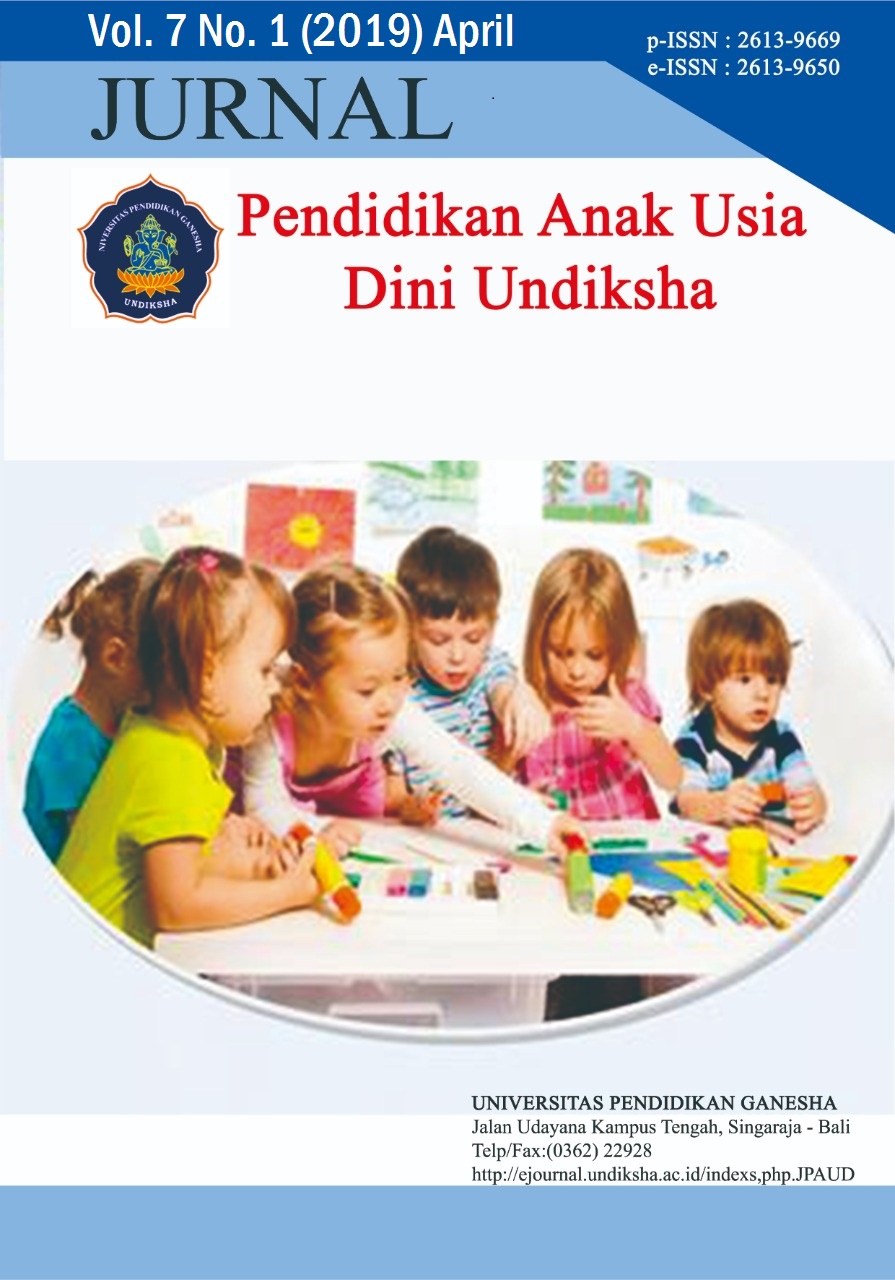PENGARUH LARI ZIG-ZAG BERBANTUAN KURSI TERHADAP PERKEMBANGAN MOTORIK KASAR ANAK KELOMPOK B TK SILA DHARMA TAHUN AJARAN 2018/2019
DOI:
https://doi.org/10.23887/paud.v7i1.18764Abstract
Penelitian ini bertujuan untuk mengetahui pengaruh lari zig-zag berbantuan kursi terhadap perkembangan motorik kasar anak kelompok B TK Sila Dharma Tahun Ajaran 2018/2019. Jenis penelitian ini Quasi Eksperimen (eksperimen semu) dengan menggunakan desain Nonequvalent Control Group Design. Populasi dari penelitian ini adalah seluruh kelompok B TK Sila Dharma yang berjumlah 96 anak. Sampel dalam penelitian menggunakan teknik random sampling, sehingga diperoleh kelompok eksperimen adalah kelompok B3 TK Sila Dharma yang berjumlah 23 anak dan kelompok kontrol adalah kelompok B2 TK Sila Dharma yang berjumlah 25 anak. Data perkembangan motorik kasar anak dikumpulkan dengan non test melalui observasi. Hasil dari penelitian ini menunjukkan rata-rata post-test perkembangan motorik kasar anak pada kelompok eksperimen adalah 85,87 sedangkan pada kelompok kontrol 78,80. Pengujian hipotesis yang digunakan dalam penelitian ini adalah uji t dengan menggunakan rumus polled varians pada taraf signifikansi 5% dengan dk = 23 + 25 – 2 = 46 dengan nilai 2,021. Diperoleh thitung = 3,07 > ttabel = 2,021. Berdasarkan kriteria pengujian, maka H0 ditolak. Dengan demikian dapat disimpulkan bahwa lari zig-zag berbantuan kursi berpengaruh terhadap perkembangan motorik kasar pada anak kelompok B TK Sila Dharma Tahun Pelajaran 2018/2019.Kata Kunci : Lari Zig-zag, kursi, perkembangan motorik kasar, pendidikan anak usia dini
This study aims to determine the effect of chair-assisted zigzag running on the gross motoric development of children in group B TK Sila Dharma Academic Year 2018/2019. This type of research is Quasi Experiment (quasi-experimental) using the Nonequvalent Control Group Design design. The population of this study were all Sila Dharma Kindergarten B groups of 96 children. The sample in the study used a random sampling technique, so that the experimental group was obtained from the B3 TK Sila Dharma group, which amounted to 23 children and the control group was the Sila Dharma B2 TK group of 25 children. Data on the gross motoric development of children were collected by non-test through observation. The results of this study showed that the average post-test for gross motoric development of children in the experimental group was 85.87 while in the control group 78.80. Testing the hypothesis used in this study is a t test using the polled variance formula at a significance level of 5% with dk = 23 + 25 - 2 = 46 with a value of 2.021. Obtained tcount = 3.07> t table = 2.021. Based on the testing criteria, H0 is rejected. Thus it can be concluded that zig-zag running assisted by chair has an effect on gross motor development in group B of TK Sila Dharma Academic Year 2018/2019.
keyword : Zigzag running, chairs, gross motor development, early childhood education
Downloads
Published
2019-07-21
How to Cite
., S. I. T., ., D. I. K. N. W. M., & ., D. I. W. D. (2019). PENGARUH LARI ZIG-ZAG BERBANTUAN KURSI TERHADAP PERKEMBANGAN MOTORIK KASAR ANAK KELOMPOK B TK SILA DHARMA TAHUN AJARAN 2018/2019. Jurnal Pendidikan Anak Usia Dini Undiksha, 7(1), 100–109. https://doi.org/10.23887/paud.v7i1.18764
Issue
Section
Articles
License
Authors who publish with the Jurnal Pendidikan Anak Usia Dini Undiksha agree to the following terms:
- Authors retain copyright and grant the journal the right of first publication with the work simultaneously licensed under a Creative Commons Attribution License (CC BY-SA 4.0) that allows others to share the work with an acknowledgment of the work's authorship and initial publication in this journal.
- Authors are able to enter into separate, additional contractual arrangements for the non-exclusive distribution of the journal's published version of the work (e.g., post it to an institutional repository or publish it in a book), with an acknowledgment of its initial publication in this journal.
- Authors are permitted and encouraged to post their work online (e.g., in institutional repositories or on their website) prior to and during the submission process, as it can lead to productive exchanges, as well as earlier and greater citation of published work. (See The Effect of Open Access)












